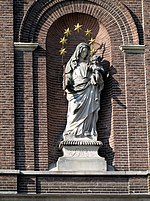Our Lady / Mother of God
The small pipe-earth statue of the Holy Virgin as the "Seat of Wisdom" once stood in a niche in a road cross on the road between 's-Hertogenbo…
The small pipe-earth statue of the Holy Virgin as the "Seat of Wisdom" once stood in a niche in a road cross on the road between 's-Hertogenbosch and Helmond near Aarle-Rixtel. Just before the Reformation (a witness spoke of before Martinus or Calvinus were) a man from the neighbourhood stole the statue to give it to his children as a toy. From that moment on his family had no peace. There was a continual deafening noise and din, and the inhabitants of the house suffered from misery and terror. The poor householder quickly put the statue back, and the misery ceased immediately. In the meantime, of course, the neighbours were fully aware, and this was the beginning of the veneration of Our Lady of Aarle-Rixtel. The neighbourhood joined forces and built a chapel on the site of the simple cross, which soon became very popular.
As in so many Dutch mercy regions, the suppression by the Protestants in Aarle-Rixtel struck, and a fearful situation arose in which reformist troops moving between 's-Hertogenbosch and Helmond terrorised the neighbourhood. This took on such proportions that no one dared to go and pray at the little chapel. Around the chapel, it became 'wild and desolate', as a writer from that time says. Some men from the village decided to demolish the chapel and use the stones to rebuild the dilapidated parish church. This again aroused the 'disapproval of the Mother Virgin', and the first and only attempt to dismantle the chapel resulted in collapsing scaffolding, broken bones and even a fatal fever in the case of the person who had demolished the altar.
The turnaround for the shrine began when the then mayor Peter Jeelis heard angels making music near the chapel. From 1597 onwards, an entirely new chapel was built, which was completed in several stages in the period up until 1616. In 1648, however, the misery with the Protestant oppressors began again. All Catholic churches were confiscated by decree, and although this was not immediately carried out in Aarle-Rixtel, the miracle statue was eventually moved to a convent, as in so many Dutch places of grace.
In 1853 the chapel was bought back by the parish priest, and in 1856 Monsignor Johannes Zwijsen, the Bishop of 's-Hertogenbosch, reinstated Our Lady's 'Seat of Wisdom' in her chapel.

